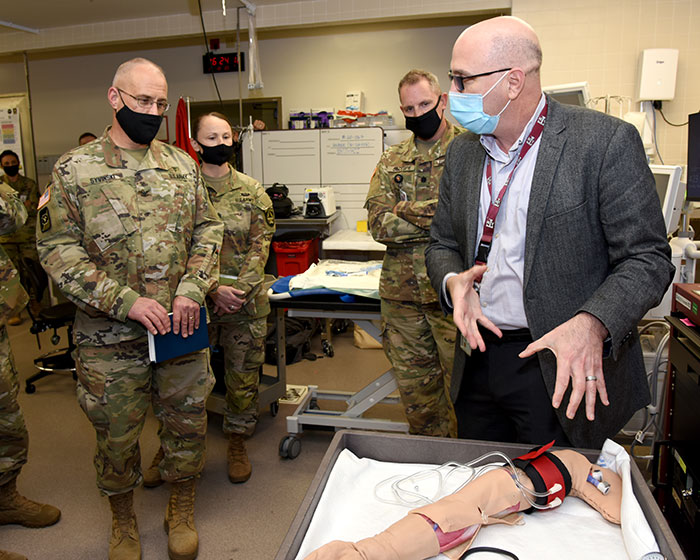USAISR Looks to Collaborate with CDID to Continue Optimizing Combat Casualty Care

The U.S. Army Institute of Surgical Research (USAISR) at Joint Base San Antonio-Fort Sam Houston, Texas (JBSA-FSH), continues to be a driving force behind the most important advances in combat casualty care. Contributing to the Institute's success has been establishing and maintaining collaborations with governmental and nongovernmental organizations to include industry and academia. To continue future success on behalf of the combat wounded, USAISR leadership met with leaders from the Medical Capability Development Integration Directorate (CDID) in November to establish a partnership to help identify capability gaps that must be addressed to deliver the highest level of medical care on the battlefield. The meeting supports the U.S. Army Future's Command "Team Ignite" concept that encourages processes and engagements to stimulate more active collaboration among internal and external groups to accelerate modernization efforts.
"As the key organization that develops concepts, that once approved, will become doctrine on how the Army will provide health service support during large scale combat operations in a multi-domain environment, CDID plays a crucial role in helping identify these capability gaps," said Col. (Dr.) Mark Stackle, USAISR Commander. "While some of these capability gaps can be addressed with changes in organizational structure or new training methods, other gaps will require updates to how we deliver combat casualty care using existing resources, or the development of new materiel products such as a new medications, medical devices, or other technologies."
Further, Stackle added his belief that medical research labs such as the USAISR currently have an opportunity to solve these capability gaps, and that teaming up with organizations like CDID will only serve to enhance future success for the Warfighter.
Col. Bruce Syvinski, director of CDID at the Futures and Concepts Center at JBSA-FSH agrees that a partnership between his organization and the USAISR is beneficial to both organizations, but perhaps especially for his staff.
"I think the relationship will provide my people with a tangible example of real scientist and researchers who develop combat casualty care products and knowledge," he said. "They will know and interact with others who share the same zeal for modernizing our Army's medical capabilities."
Notably, Syvinski also believes a collaboration between the USAISR and CDID could eventually benefit service members on future battlefields since both organizations are focused on developing concepts and integral conceptual products for the Warfighter.
"We are committed to the development and specifications for and gain Army approval for new medical supplies and medical equipment," Syvinski said. "We conduct experimentation in which we evaluate our new conceptual ideas or prototype medical equipment and then we integrate and ensure that other appropriate organizations know what we are doing and how and what they can do to support our efforts."
The meeting in November afforded both organizations an opportunity to brief each other on their missions, visions, and capabilities; which in turn led to discussions on how both will benefit from an enduring collaboration.
"The USAISR's team of scientists, clinicians, and support staff are experts in their field, and have a long history of delivering new products and knowledge solutions to some of the most challenging battlefield medicine challenges," Stackle said. "By working closely with each other, CDID and USAISR will have the opportunity to better understand not only what will be required to delivery care on the future battlefield, but also a more comprehensive grasp of what the state of the science is and what military medical research can deliver in support of these efforts."
Both Syvinski and Stackle and look forward to establishing an enduring partnership with an organization that left a positive impression on him.
"I thought the commander and staff were professional, passionate about their mission, and committed to developing products to provide the best possible care for our soldiers and service members," Syvinski said. "I think that a continued collaboration, both in person and virtually, will improve our ability to conceptualize what is possible and feasible to provide the best medical care and solutions to our soldiers and service members on the battlefield."














